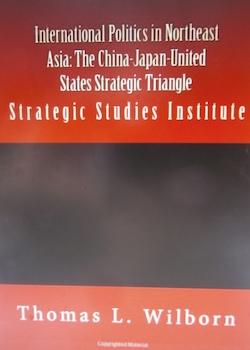International Politics in Northeast Asia: The China-Japan-United States Strategic Triangle

By Thomas L. Wilborn
Strategic Studies Institute
published February 2013 (originally published March 1996)
by CreateSpace Independent Publishing Platform
58 pages
ISBN 1482339471
Review by Michael Sullivan
In order to understand the events of today it is vital to analyse the past; however by understanding the present it is possible to see a glimpse of the future. Nearly twenty years ago Thomas L. Wilborn completed one of his final papers regarding the strategic triangle between China, Japan and the USA and its possible future. Reading it today provides an intriguing insight into recent developments in Japan. Thomas L. Wilborn was a research professor of National Security Affairs and an Asian Specialist with the Strategic Studies Institution of the U.S. Army War College. In the 1990s he published several studies on Japan’s military, on dangers in North East Asia and also on US policy in this region.
As an overview into the background of North East Asia an important consideration is that during the Cold War there was a bipolar world which saw Japan and South Korea as key allies of the US while China and Soviet Russia supported North Korea. To complicate this, a breakdown of relations between China and Soviet Russia meant that China also collaborated with the US to frustrate Soviet expansion, a result of which was that the border between Russia and China was heavily manned. At the time of the Cold War China maintained hundreds of thousands of troops as well as thousands of pieces of hardware in this area, since the Cold War the Russian military presence has been greatly reduced while trade and relations have improved. This is a relevant fact as it has meant that China could focus its military resources in other areas, for example on its navy, and establish new approaches with its neighbours. Without the priorities of the Cold War, Japan as well could be more independent with its policies, which is partly why Wilborn could describe the Northeast Asian political system in 1996 as “characterized by great uncertainty and unpredictability.” This point is as true now as it was nearly twenty years ago as we have seen with the nuclear tests in North Korea, the shelling of South Korea and sinking of a ship in 2010, and the recent escalation in the dispute over the Senkaku/Diaoyu islands including the alleged radar lock on a Japanese naval ship by a Chinese frigate. Rather chillingly Wilborn theorised that Northeast Asian countries would be more likely to “revive historic grievances, and […] pursue them even at the risk of conflict.”
Within the background of the Senkaku/Diaoyu dispute Wilborn provides a convincing explanation about how the leadership of China has evolved from those who led to the revolution to those who achieved their rank within the state bureaucracy, meaning that officials are less likely to be secure in their position while “contenders for power will emphasize nationalistic symbols and causes.” This has been reflected in the rather high profile fall of Bo Xilai in 2012 as well as the more aggressive dialogue over of territory in the China South Seas and also over the islands mentioned above. When Wilborn wrote his paper China often rebuked Japan for claiming sovereignty over the islands, he described this as being “largely pro forma exercises, however, partly to exploit the Japanese sense of guilt” (in reference to historical events). As we now know this has developed to a more aggressive claim on the islands.
For Japan the end of the Cold War, as well as fear of disengagement in Northeast Asia by the US, has had important implications on its military, its foreign policy and international role. For example, the Self Defence Force was established in 1954 and has since been authorised to be deployed abroad since 1992, more recently Japan increased its defence budget for the first time in 11 years, although Wilborn described Japan’s military forces as “not valued institutions” clearly territory disputes can change this attitude quickly.
This paper regarding the strategic triangle of China, Japan and the US also covers the other players in this important area of the world such as Russia, South Korean, North Korea, and Taiwan. However, what is most clear, then and now, is how complicated the relations are between all of the different countries as strong economic ties are laid over different political ideologies and foreign policies. Insightful comments are made on the on-going situation with North Korea such as how expensive reunification would be (in the region of a trillion dollars) and therefore is not desirable, while China has a commitment to North Korea that it can’t easily withdraw, nor could it allow a US friendly government to be in control. This leaves North Korea in limbo as there is no clear resolution, while as shown in recent years Japan and South Korea frequently face tense situations due to provocative actions.
The entire original paper can be downloaded as a PDF file here.

